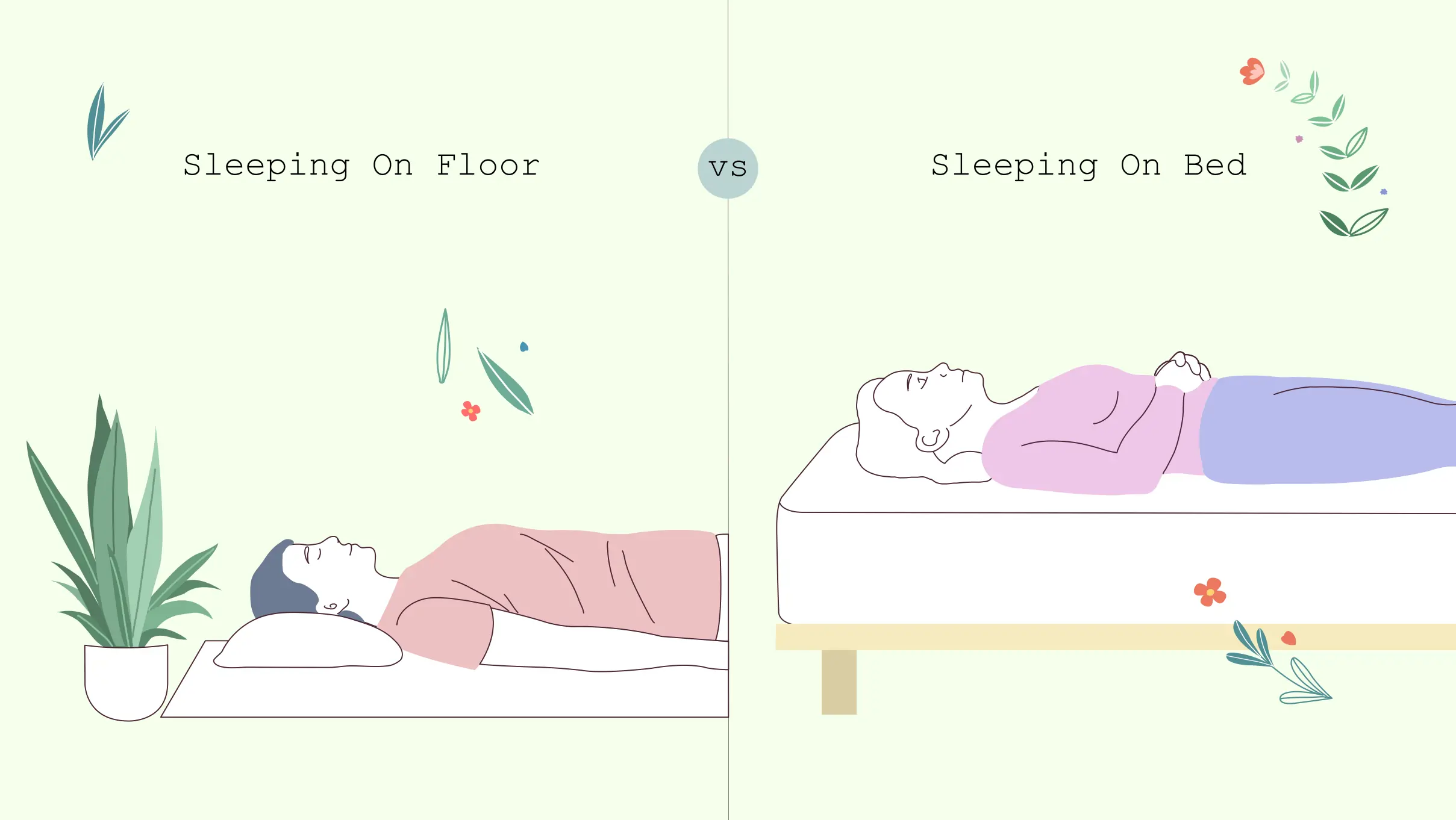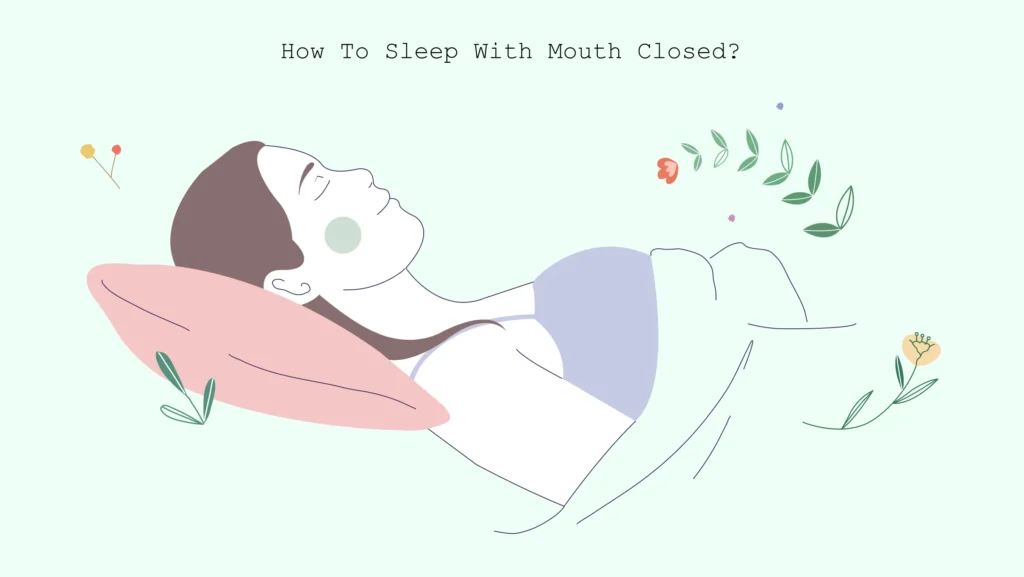Sleeping on the Floor: Benefits, Side Effects & How to
Written by


The evolution is remarkable, from sleeping on the floor during early times to sleeping on a comfy and lush mattress. Sleeping on the floor is undoubtedly affordable, especially practical for people shifting to a new place. Besides the money-saving part, sleeping on the floor is often preferred because it helps reduce back pain, enhances posture, and offers a cooling feel. At the same time, lying on the floor has disadvantages like allergic reactions, less comfort, becoming a hub for mold and mildew, and so on.
This article will comprise every trivial detail about sleeping on the floor. So if you are interested in knowing, get going with it.
Sleeping on Floor vs Bed
People who have just moved into a new house, or hostel, often consider sleeping on the floor. Sleeping on the floor can be done in two ways: Sleeping directly on the ground and sleeping on the floor over a mattress. Both of these approaches have advantages and disadvantages of their own.
While sleeping on the floor directly might be affordable and cooling, it can cause stiffness for some. There is not much room for comfort if sleeping directly on the floor, and you will soon become friends with dust, mites, bed bugs, and more.
On the other hand, sleeping on the floor on a mattress will give you more cushioning. But, at the same time, your mattress will be risked by bed bugs, mites, and more. Moreover, placing the mattress directly on the floor will inhibit airflow and violate certain mattress warranties.
Benefits of Sleeping on the Floor
Sleeping on the floor opens the door to plentiful health benefits. Interested in knowing? Get going with the below points.
Drop in Back Pain
People experiencing back pain for a prolonged period can try sleeping on a firm surface like the floor to reduce the pain. It has been backed by research that sleeping on a firm surface has helped relieve pain in your spine, and posture is absolutely in a balanced position. There is no chance of sinking into the mattress leading to additional pain.
Though, lying on the floor might not reap many benefits for side sleepers. This is because side sleepers require more cushioning on their sides to provide relief to their pressure points; which is not the case with back or stomach sleepers.
Might Enhance Posture
When you are sleeping on the floor, your spine is already in an upright position due to a firm surface. This leads to an improved posture, further diminishing the possibility of aggravated health issues like scoliosis, migraines, headaches, and joint pain, and decreases neck pain as well. Have you ever felt grumpy because of backache after waking up? Sleeping on the floor might bid goodbye to this problem as it also helps elevate your mood.
Might Help with Blood Circulation
One of the benefits of sleeping on the floor is an increase in blood circulation. How does this happen? When you are lying on the floor, your lumbar spine, hips, and shoulders are evenly spread out, ultimately leading to improved blood circulation.
Offers a Cooling Sensation
Sleeping on the floor means sleeping closer to the ground, which offers a cooling sensation. For people residing in a humid region, sleeping on the floor emits a soothing feel. Though, you can always opt for a gel-memory foam mattress if you need a cooler surface. Those are specially curated to alleviate hot sleepers. Though sleepers need to remember that it is best to sleep in a temperature range of 60 to 67 degrees Fahrenheit.
Budget-Friendly
Sleeping on the floor is a great solution to saving quite some amount of money as there is no need to purchase a bed foundation or bed frame. You might buy a mattress or even sleep directly on the floor over a carpet if you feel like it.
Disadvantages of Sleeping on the Floor
You might wonder why sleeping on the floor has disadvantages when all our ancestors spend thousands of years sleeping like that. And here the mattresses make a grand entry. The below disadvantages of sleeping on the floor might help you in your decision-making process.
Allergies
Is sleeping on the floor good for you? The answer would be ‘No’ if you experience dust allergy quite often. Sleeping on the floor makes allergens, dust, bed bugs, mites, and other insects think of the bed as their hub. They can climb in, and stay with you whenever they want, leading you to undergo certain respiratory issues. If you often find yourself with a runny nose, itchy throat and eyes, and coughing, you are experiencing allergic reactions from lying on the floor.
Mould and Mildew Buildup
Why do we buy a mattress foundation in the first place? One of the major reasons is that it offers continuous airflow and doesn’t trap heat. But, when you are placing the mattress on the floor, it is trapping your body heat and sweat, thereby failing to disperse it out properly. This leads to the formation of mould and mildew causing allergic reactions.
A mattress that has become a dwelling of mould and mildew needs to be thrown away.
Quite Uneasy
The reason why people spend money on purchasing a bed frame, mattress foundation, and other bases is for attaining comfort and sound sleep. There is little to no cushioning when sleeping on the floor as compared to a lush mattress. Therefore, studies have found that sleeping on very firm mattresses has resulted in fewer health benefits. Though it might be beneficial for back pain, the lumbar spine, shoulders, and neck area receives excess pressure build-up and soreness.
Who Shouldn’t Sleep on the Floor?
There is a group of people who should completely avoid sleeping on the floor. Are you among them?
Pregnant Women or New Mothers
It might be harder for pregnant women to get down to sleep, and stand back up in that condition.
Seniors
With ageing comes weak bones and an immune system. Therefore, the holders might find it difficult to bend their knees to get to bed and wake up. It might aggravate their joint pains.
People having mobility problems
Someone having mobility issues or joint issues like arthritis might find it a struggle to get down to the floor and get up, especially right after waking.
People having blood circulation issues
People experiencing anaemia and diabetes might find the cooling temperature from the floor harmful.
Sleeping on the Floor While Pregnant
While it may feel comfortable to sleep on the floor while pregnant, getting down and standing back up might be a concerning factor. If this makes you uncomfortable, avoid floor sleeping completely. On the other hand, sleeping on the floor with your baby is considered helpful in case of co-sleeping. Co-sleeping in bed is discouraged because of the following reasons:
- Sudden infant death syndrome (SIDS)
- Suffocation
- Falls
You might feel like offering soft surfaces like pillows or blankets to comfort the baby. But in reality, these soft surfaces might block their airways. Though it is always necessary to speak to your paediatrician before making your baby sleep on the floor to avoid any health issues like a cold.
How to Sleep on the Floor Properly
If you are convinced about sleeping on the floor, then start by implementing the following steps.
Ensure a Clean and Clutter-free Floor
If you are sleeping on the floor, ensuring a clutter-free and tidy area will aid in a peaceful sleep. The area needs to be vacuumed, swept, and mopped daily to keep dirt, allergens, and debris at bay. The surrounding of your mattress needs to be clear for you to not tumble and fall when waking up with sleepy eyes.
Design your Bed Area
Just like you would have decorated your regular bed frame and mattress, indulge in designing your sleeping area on the floor as well. If you wish to keep it minimal, you might sleep on a mat or blanket. If you wish to give an edge to the design, opt for more cushioning like the ones provided by sleeping bags, futons, or memory foam toppers.
You can also try out the foldable or rolled-up mattresses for floor sleeping. Another option is placing the mattress directly on the floor without any bed frame.
Sustain your Sleep Position
You may be surprised to notice that your preference for sleeping position has completely shifted after moving to sleep on the floor. But, whatever sleeping position you choose, there are pillows to give you support.
If you are a back sleeper, you can place a thin pillow under your lower back, and another pillow under the knees for relieving pressure. For supporting the spinal alignment, head pillows will perfectly fill the gap between the neck and the floor.
If you are a side sleeper, you can try putting a pillow between the knees for relieving tension. For more comfort, consider placing a thin pillow between the waist and the floor.
Stomach sleepers might find difficulty sleeping on the floor because of back and neck pain. To avoid this, try sleeping with a head pillow or a thin one.
Try it Out With a Nap
You might have been advised to sleep on the floor to reduce back pain. But the complete shift from the mattress to the floor might be problematic. Therefore, try sleeping in different sleeping positions and test it out by napping at first. If it doesn’t feel good, you can always choose to move back to your mattress.
Use A Thin Pillow
When you sleep on the floor, you must ensure that you properly support your back and neck. Therefore, using a thin pillow is always beneficial as it won’t strain your back and neck.
Use A Thin Mattress
If you like sleeping on the floor but don’t enjoy the overly hard surface, then you can use a thin cotton mattress for some cushiony comfort. This will yield the benefits of sleeping on the floor and offer you some much-needed comfort.
Conclusion
Sleeping on the floor might save you quite an amount of money but will also make you allergic to dust. Moreover, if you are a side sleeper, lying on the floor is not a favourable option since it doesn’t offer enough cushioning. Before jumping to a conclusion, consider the benefits and disadvantages of sleeping on the floor.
FAQs
Does sleeping on the floor help with sciatica?
Many people have found that sleeping on the floor might help sciatica.
Can you put a mattress on the floor?
Not all mattresses can be put on the floor, like memory foam mattresses. Check your warranty to note if your mattress is suitable to be put on the floor, otherwise, it will be void.
Can you sleep on the floor without a pillow?
Sleeping on the floor might be beneficial for your back, but pillows are required to receive the much-required cushioning for your body.
Why do Japanese sleep on floors?
Japanese follow their age-old tradition of sleeping on the floor which can be traced back to the 10th century.
people like this article
Written by








